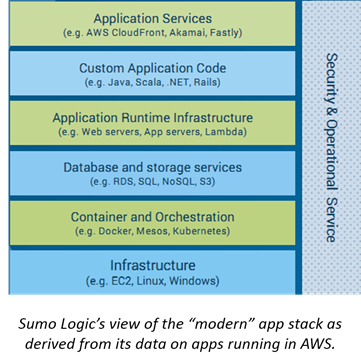新興技術を採用したAWSのパブリッククラウドスタック

ネイティブにデプロイされ、パブリック クラウドに移行されるアプリケーションの種類について推測するブログや記事は数多くあります。 モバイル アプリは「クラウド生まれ」のカテゴリの 1 つと見なされることが多いですが、エンタープライズ モバイル アプリなのかコンシューマー グレードのアプリなのかを詳細に調べることができないため、どちらにせよ明確に判断することは困難です。
したがって、パブリック クラウド内のアプリのあらゆる側面を詳細に分析したレポート、特に実際のデータから生成されたレポートを見るのは興味深いことです。 Sumo Logic は最近まさにそれを実行し、AWS パブリック クラウドで実行されているアプリケーションに関する貴重な洞察を提供するレポートをリリースしました。 これは、Sumo Logic が管理するアプリとインフラストラクチャから生成されたデータからまとめられたもので、もちろん慎重に匿名化されています。 Sumo Logic は、AWS クラウドでアプリケーションを実行している顧客が 1,000 社を超えており、その調査結果には、その環境でコンパイルされているアプリケーション スタックに関する非常に興味深いデータ ポイントが含まれていました。
たとえば、コンテナの採用に関するさまざまなデータ ポイントが存在します。 ほとんどは、コンテナ関連技術のクローズドコミュニティ内で実施された調査から得られたもので、採用率が高くなる傾向にあります。 採用率が 62% だという報告も見ました。 逆に、企業コミュニティ全体で実施される調査では、組織内でコンテナを導入している回答者がうっかり見逃され、結果がほとんど記録されないレベルに偏ってしまう可能性があります。 したがって、Sumo Logic の調査結果によると、本番環境 (AWS) での Docker の使用率は約 15% であり、Lambda (サーバーレス アーキテクチャをサポート) の採用率が同様であることも重要です。
また、「従来の(RDBMS)データベースよりも NoSQL データベースを使用する顧客が多い」という調査結果も興味深いものでした。 注目すべきことに、リストの下位には、従来のエンタープライズ向け RDBMS ベンダーが並んでいました。 それはそれほど驚くべきことではありません。 ほとんどの企業では、非常に大規模な(本当に大規模な)RDBMS をクラウド環境に移行する可能性は低いでしょう。 10 年、20 年、あるいはそれ以上のデータをクラウドに移行するという課題があるだけでなく、そのデータベースに依存する数十、数百の既存の (データ センターにバインドされた) アプリからのクトゥルフのような触手も存在します。 しかし、最初からやり直すのであれば、最新のアプリ フレームワーク内でのスピードとサポートで知られる NoSQL などの、より新しくクラウドに適したテクノロジーを採用するか、オープン ソース オプションを選択するのが合理的です。 とはいえ、使用されているデータベースのトップ 4 のうち 2 つは NoSQL (Redis が 18% でトップ、Mongo が 16% でわずかに遅れをとっています) ですが、他の 2 つは従来の RDBMS です。 MySQLは17%で2位につけ、PostgreSQLは11%で4位となった。
最後に、Sumo Logic は、「AWS アプリケーションのほぼ 3 分の 2 が AWS 監査サービス (CloudTrail) と VPC フローログを使用している」ことを発見しました。 これは、あらゆる業界や市場においてセキュリティが継続的に優先されていることと一致しています。 また、クラウド対応のインフラストラクチャとシステムが市場に登場し続ける中で、どのような「クラウド サービス」を他のソリューションと統合する必要があるかについても、ある程度の洞察を提供します。
Sumo Logic のレポートはここからダウンロードできます。また、Sumo Logic は今後さらに詳細な調査を行う予定であると述べているので、そちらにも注目してください。
